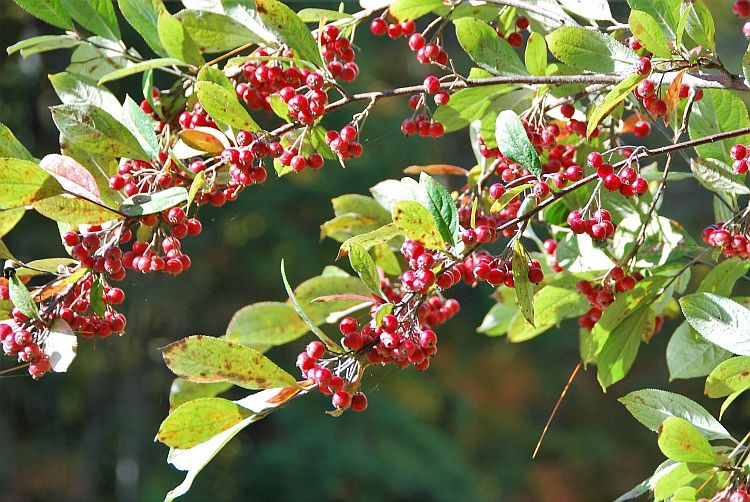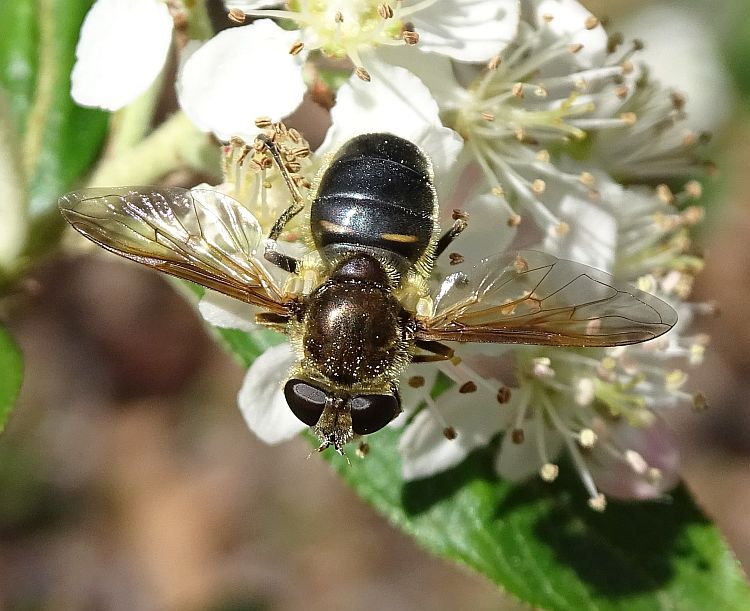Red Chokeberry Shines in All Seasons
By Betsy Washington, Northern Neck Chapter
Red Chokeberry (Aronia arbutifolia) is a versatile landscape shrub that shines in all four seasons of the year. In spring, showy clusters of up to 25 pristine white, or pink-blushed flowers light up the garden. Throughout summer the foliage is a lustrous dark green, then ignites in fall with shades of scarlet, orange, and even purple, rivaling the invasive burning bush but so much more vital for wildlife. Dense clusters of glossy red berries, (technically pomes, like apples), ripen in late summer and fall, and persist well into winter.
As you might guess from the common name, Chokeberry, the fruit are dry, bitter and astringent to humans when eaten raw, but delicious when used for preserves and jellies. The fruit becomes more palatable through cycles of freezing and thawing during winter, and becomes an important food for over-wintering songbirds when little else is available.
Red Chokeberry typically reaches 6–8’ in height and 3-5’ in width, but in damp soils it tends to sucker into small colonies that spread much wider, helping to protect shorelines and low areas from erosion while providing four season interest to us and food for wintering birds. Red chokeberries naturally range from Nova Scotia south along the coast to Florida and west to Texas and Ohio. They often occur in bogs, seepage or tidal swamps, low flatwoods or around ponds, but they also occur in dry thickets, and upland forests.
This shrub is tolerant of a wide variety of habitats from forested to sunny, from moist to wet, and even dry soils, and even periodic flooding, drought and pollution. This adaptability lends it to a variety of garden uses. Red Chokeberries are rarely bothered by pests or diseases, but occasionally can have minor leaf spotting or twig dieback. Alas, however, they are not very deer resistant and should be protected when young.
Aronia arbutifolia can be a showstopper when planted in masses or allowed to sucker into colonies along streams, ponds or other low areas, where the spring floral show and fall color and fruit display are amplified. They also add beauty and functionality to a rain garden or other low area prone to occasional flooding. Alternatively, they are easily limbed up into an elegant small tree, exposing their smooth gray stems. Grown in this way, they make an attractive small specimen tree, or arched over an entrance or accenting a mixed border. Any unwanted suckers can be easily removed and used to propagate more shrubs or shared with friends.
Red Chokeberries, and their close cousins Black Chokeberries, provide high wildlife value to any garden. In April the flowers provide nectar and pollen to native bees and butterflies including mason, miner, and bumblebees and even little known but diverse flower flies. Aronia are featured plants in such esteemed gardens as those at the Arnold Arboretum and Smithsonian Institution that are dedicated to supporting pollinators. Maeve Coker, a naturalist from Essex County says,
I’ve documented at least 30 species of pollinators (flower flies, bees, and butterflies) utilizing Red Chokeberry. If that doesn’t speak volumes for the value of the plant, I’m not sure what does.
These beautiful plants are also a host for several species of moths and hairstreak butterflies providing critical food for their caterpillars. The showy but astringent fruit persist well into winter, when they become important to a wide variety of over-wintering songbirds. In the meantime, they serve to light up a winter landscape and delight humans as well.
Donald Leopold in his 2005 book, “Native Plants of the Northeast: A Guide for Gardening and Conservation” says it best:
Native shrubs like red chokeberry make one wonder why so many much less attractive, non-native shrubs are continually planted instead.





Thank you for this useful & interesting information; and for the photos. I love this journey of learning how to create a beautiful garden for people & wildlife to share.
Is the Aronia Melanocarpa also a native plant? I have seen it listed on other sites, but I can not access it on this site.
Yes the melancarpa is also native! Often slightly shorter and wider then the arbutifolia but has essentially the same habit and attributes!
Is it possible to prune a red chokeberry so that it grows more like a tree, instead of a shrub. I’m thinking of incorporating this into a landscaping bed in our front yard. I’m looking for a smallish tree so I can layer some shorter plantings in front of it, without blocking our house’s windows (our house is slightly elevated from the ground, so with a 6-8 foot tree, the window would be above the top of the tree).
Your questions is exactly my question. I’m hopeful that someone with experience with this species from VNPS is able to answer this question.
See this Utah State University reference which confirms it is quite possible to prune and grow this as a tree. https://extension.usu.edu/yardandgarden/research/chokecherry-in-the-garden#:~:text=Pruning%20should%20be%20carried%20out,such%20as%20peach%20or%20cherry. Sounds like deer resistance is lower on Red Chokeberry, so fencing around a younger plant may to be required.